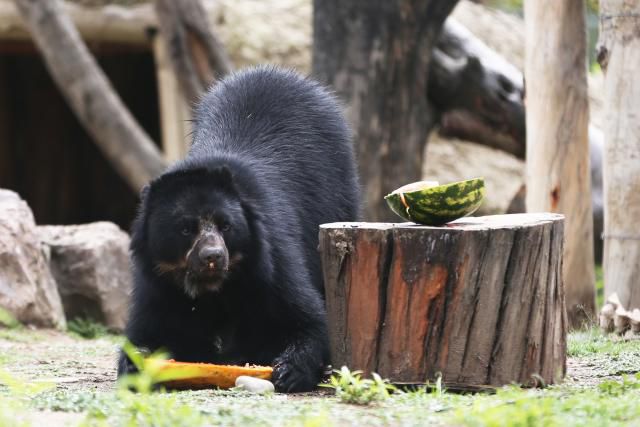He spectacled bear, the only species of bear in South America and one of the largest mammals in the region. Six specimens of these bears have become symbols of resistance against these threats because they are considered an icon of the region that is at serious risk due mainly to poaching and illegal trafficking of wildlife in Boliviaaccording to biologist Omar Rocha, administrator of the Vesty Pakos Municipal Biopark.
The spectacled bears They live in the inter-Andean valleys and subtropical humid forests from western Venezuela, passing through Colombia, Ecuador, Peru and Boliviato the north of Argentina.
In Bolivia are in the regions of La Paz, Cochabamba, Santa Cruz and Tarija, some “sheltered” in protected areas such as the Cotapata and Madidi reserves in La Paz, one of the most biodiverse in the world, or the Amboró park in Santa Cruz and the Carrasco park in Cochabambino.
These animals are characterized by their dark fur and white spots around the eyes and cheeks, which resemble animals. glasses u mask.
Rocha highlighted that he is also considered a “umbrella species“, since the conservation actions taken to protect them “have an impact on the habitat and other species” who live in the same areas.
vulnerable species
The bears are “chased” either “hunted” because, for example, in some rural communities they see them as destroyers of crops, Rocha said. Although the impact on crops is “little significant”, there have been cases in which local people hunt the ycumarisor separate the bear cubs of their mothersand they begin to breed them in captivity”, he indicated.
But when the animals grow, “They do not know what to do” with them and there actions are coordinated with the departmental governments or bodies such as the Forest Police and Environmental Preservation (Pofoma) to rescue them and take them to wildlife custody centers, such as the Vesty Pakos biopark.
That was the case of the jucumaris Juqui, Luna, Cucho, Eddi, Balú and Rufina, who arrived at the biopark over the course of the last 15 to 20 years.
“The six copies come from illegal traffickingof traffic and rescue situations that have been done in different locations“Rocha noted.
There is also the case of Ajayu, a jucumari who was beaten and stoned in a community in Cochabamba because he allegedly tried to attack a child.
Ajayu, an emblem to combat cruelty against animals, was rehabilitated in the biopark and today lives in a wildlife refuge.
The youngest
Juqui is the bear youngest of the biopark, where he arrived in 2020 after being rescued from the community of Tablas Monte, in the central region of Cochabamba, where they had him as “pet“, the person in charge of the center’s Wildlife Conservation and Management area, Fortunato Choque, told EFE.
He bear cub He was rescued from a private house where he lived in a small cage and arrived at the biopark malnourished and with dull fur, according to a documentary from that center.
Little Juqui went through a period of quarantine and rehabilitation, and a process of “adaptation so that it can get along with the rest of the Bears”, until it was finally able to be fully integrated into the environment intended for the Jucumaris in the biopark, Choque said.
Today Juqui is bigger, his fur shines and he shares a space of more than 6,000 square meters with Luna, Eddi, Balú, Cucho and Rufi.
The animals receive all the attention of the biopark’s technical team, including the “enrichment“, a management technique for “promote natural behaviors” of the species, encourage their movement, prevent diseases and “ensure your well-being“, the person in charge of the park’s Biology subarea, Diego Maldonado, told EFE.
Food enrichment includes a nutritious and varied diet, with different presentations, such as hiding food in piñatas made of egg cartons or tires, while physical enrichment is achieved through elements such as pools, swings and dens.
Clash explained that “once they separate it from its parents it is impossible, it is inhumane to let the bear go free”, so it is appropriate to take it to an experienced custody center, and also influenced people to understand that wild animals should not be seen as pets.
Source: Gestion
Ricardo is a renowned author and journalist, known for his exceptional writing on top-news stories. He currently works as a writer at the 247 News Agency, where he is known for his ability to deliver breaking news and insightful analysis on the most pressing issues of the day.












